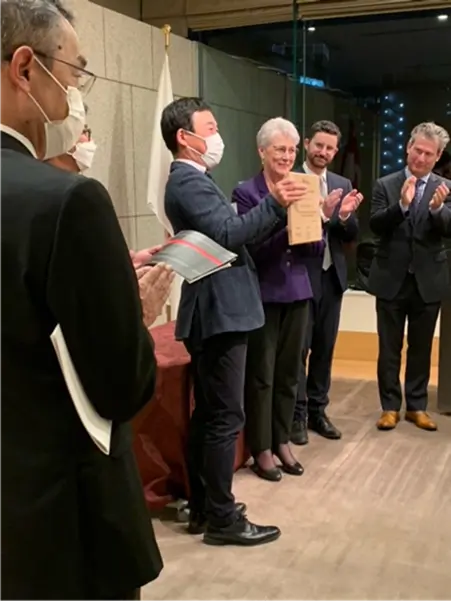
Canada-United States-Mexico Agreement
Four hundred and ninety-five million consumers and a combined GDP of over US$24 trillion makes North America one of the world’s largest economies. Because of this, the United States (U.S.) and Mexico are ideal locations for trade and investment, and the now year-old Canada-United States-Mexico Agreement (CUSMA) gives British Columbia (B.C.) businesses an added competitive edge when expanding into these markets.
Free trade agreements (FTAs) such as the CUSMA reduce trade barriers within the North American market, providing an array of opportunities to expand your business. Before we explore the benefits of this agreement, let’s take a brief look at the CUSMA’s history to understand how we got to where we are today.
What are FTAs? What is the CUSMA?
FTAs aim to increase the free flow of goods, services, capital and labour by reducing trade barriers. In doing this, it is easier for businesses to engage in international trade and investment in participating jurisdictions. Over time, this can result in increased competitiveness, economic growth, and a higher standard of living for citizens living in countries who participate in the agreement.
The CUSMA is an FTA between Canada, the United States of America, and Mexico that entered into force on July 1st, 2020. Many B.C. exporters may be familiar with the CUSMA’s predecessor, the North American Free Trade Agreement (NAFTA). Upon its implementation in 1994, the NAFTA created the largest free trade area in the world and helped citizens of all three member countries realize that promised increase in standard of living and growth. The CUSMA modernized and replaced the NAFTA, reaffirming and strengthening the dynamic trade relationship and deeply integrated supply chains on the North American continent.
The CUSMA brings the NAFTA into the digital age while maintaining key fundamental elements of the original agreement, such as the NAFTA’s elimination of practically all tariffs, its dispute settlement mechanisms, and temporary entry for certain categories of business people. Notably, the CUSMA includes important modernizations such as a digital trade chapter, stand-alone chapters on the environment and labour, and greater emphasis on inclusive trade. Learn more about the similarities and differences between CUSMA and NAFTA.
How can the CUSMA Benefit your B.C. Business?
Let’s look at a few different ways this agreement could benefit your business:
Goods: The CUSMA maintains zero percent duties on practically all Canadian goods exported to the United States or Mexico. For example, the CUSMA allows B.C. businesses in the seafood sector to export products that meet the CUSMA rules of origin duty free to the United States. The U.S. accounts for approximately 60 percent of B.C.’s seafood exports. On the other hand, CUSMA provides businesses in the life sciences sector with preferential access to B.C.’s largest market for medical devices and life sciences products. Additionally, the agreement modernizes administrative procedures such as rules of origin, origin certification and customs administration and trade facilitation.
Services: The CUSMA facilitates trade for B.C. service providers looking to do business in the United States and Mexico. For example, the agreement outlines that member countries cannot impose limitations on the number of service providers practicing in their jurisdictions. Like other trade agreements, the CUSMA also incorporates national and most-favoured nation treatment rules, which mean that B.C. service providers are treated equally to domestic U.S. and Mexican providers as well as foreign companies that are receiving preferential treatment from these parties. Learn more about the cross-border trade in services under the CUSMA here.
Business entry: The CUSMA allows certain categories of B.C. professionals to temporarily enter the United States or Mexico for some business-related activities. This makes it easier for businesses to engage in trade and investment opportunities with companies located in CUSMA partner countries. Learn more about temporary entry under the CUSMA here.
Digital trade: The CUSMA aims to facilitate and build trust in digital trade. The agreement includes commitments to facilitate public access to, and use of, open government information to support economic and social development, competitiveness, and innovation. Learn more about digital trade under the CUSMA here.
Investment: The CUSMA supports a predictable, fair, and rules-based investment climate, providing transparency for companies engaging in investment opportunities in the three CUSMA Parties. While the CUSMA removes the investor state dispute settlement (ISDS) mechanism that existed under the NAFTA, the NAFTA’s ISDS will remain in place to investors with respect to their existing investments for a period of three years after entry-into-force of CUSMA. Learn more about investment under the CUSMA here.
Inclusive trade: The CUSMA aims to promote an inclusive trade environment for all. The agreement includes provisions to encourage the participation of small and medium-sized enterprises (SMEs), women and Indigenous-owned businesses in trade. SMEs employ approximately 10.7 million Canadians, making up a majority of the labour force. In 2019, Canadian SMEs exported approximately CAD$159.2 billion in goods to the United States, demonstrating that there are tremendous opportunities for businesses of all sizes to reap the benefits of free trade. If you operate an SME in B.C. and are looking to expand your business, the United States is a great place to start – check out this resource to learn more about how SMEs can benefit from the CUSMA. To learn more about the CUSMA’s inclusive trade provisions, please visit these pages: trade and gender and trade and Indigenous peoples.
How to Claim Preferential Treatment under the CUSMA
The benefits of the CUSMA’s tariff eliminations are not automatically applied to your business when shipping goods to and from the United States and Mexico. To reap the benefits of the CUSMA, the importer must claim preferential tariff treatment.
The first step in claiming preferential tariff treatment is to classify your products. Goods are classified using Harmonized System (HS) codes. This resource can help you find your product’s HS codes, and the Canada Tariff Finder serves as another valuable tool to help determine your goods’ tariff rate under the CUSMA. It is recommended that you seek external professional advice to ensure the accuracy of your classification when engaging in international trade.
4 Steps to Claim Preferential Tariff Treatment [PDF]
Additionally, your goods must qualify as originating in a CUSMA partner country to be eligible for preferential tariff treatment. To prove a product’s origin, the exporter must provide a Certificate of Origin. These certificates do not have a mandatory format; however, there are some minimum requirements that must be contained in the document, such as classification codes, the names of certifiers, and so on. This certification can be completed by the importer, exporter, or producer. Check out the detailed requirements for the CUSMA Certificate of Origin on the Canada Border Services Agency webpage.
If you are unsure if your goods have the correct tariff classification or meet the CUSMA’s rules of origin, consider applying for an advance ruling. An advance ruling is a written document from the customs authority of the country your product is entering that interprets and applies the rules in relation to your product. This provides an additional level of certainty that your goods qualify for preferential tariff treatment. To learn more about origin procedures and advance rulings under CUSMA, check out this resource page.
No matter your business’s sector or size, the CUSMA is a tool that allows your company to become more competitive in the North American market. For more information on the CUSMA and additional resources on free trade, check out our Trade Agreements webpage. To stay up to date on the array of international business opportunities available to B.C. businesses, follow Trade and Invest B.C. on LinkedIn and Twitter today.
Related News
We Can Help
Trade and Invest BC helps facilitate foreign direct investment and has Trade and Investment Representatives in markets around the world. Contact the representative nearest you for support in investing in British Columbia.




